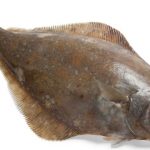 The scientific name for the halibut is hippoglossus, Greek for horse tongue, so called because of its wide, flat shape. In contrast, its more common name, halibut, derives not from its shape but from when the fish was usually eaten—on Church holidays, or, as they were originally called, on holy days. The halibut, therefore, is literally a holy butt, the word butt being an old name for flatfish. This butt—which derives from a Germanic source meaning blunt, a source that also gave rise to buttocks—appears also in turbot, another sort of flatfish. At one time it was believed that turbot took its name from the Latin turbo, meaning tornado, as if the fish somehow spun through the water as it swam. In fact, however, the first syllable of turbot comes from the Swedish torn, meaning thorn, the connection being that the turbot has thornlike nodules on its back. In English, turbots were first referred to by name in the early fourteenth century, halibuts in the fifteenth.
The scientific name for the halibut is hippoglossus, Greek for horse tongue, so called because of its wide, flat shape. In contrast, its more common name, halibut, derives not from its shape but from when the fish was usually eaten—on Church holidays, or, as they were originally called, on holy days. The halibut, therefore, is literally a holy butt, the word butt being an old name for flatfish. This butt—which derives from a Germanic source meaning blunt, a source that also gave rise to buttocks—appears also in turbot, another sort of flatfish. At one time it was believed that turbot took its name from the Latin turbo, meaning tornado, as if the fish somehow spun through the water as it swam. In fact, however, the first syllable of turbot comes from the Swedish torn, meaning thorn, the connection being that the turbot has thornlike nodules on its back. In English, turbots were first referred to by name in the early fourteenth century, halibuts in the fifteenth.
This is the largest type of flatfish, typically caught when weighing between fifty to one hundred pounds. Its flesh is generally considered to be dry or lean, with pockets of fat that produce the widely used oil. It is usually sold in steaks or, on occasion, as fillets.
The halibut is a very large flat fish that can be found in the North Pacific and the North Atlantic. The young fish, which weighs about 3 pounds, is in season year-round and is known to have the best flavor. Larger halibut can weigh up to 200 pounds and are typically sold in steaks or fillets. Despite its size, halibut is a delicate and flavorful fish that can be cooked in a variety of ways, including grilling, baking, and pan-frying.
